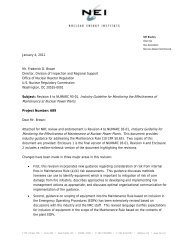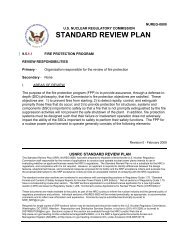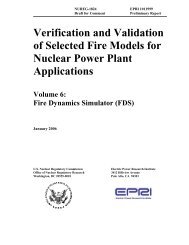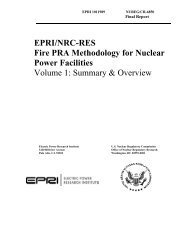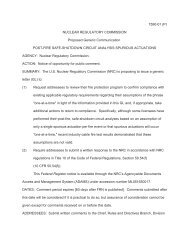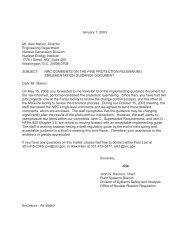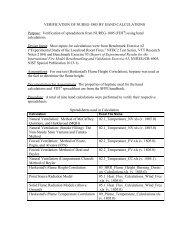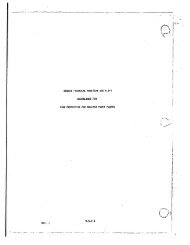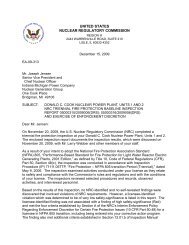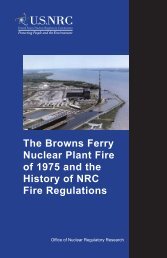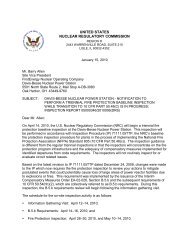Mass Notification Systems: Design Challenges for the FPE Wayne D ...
Mass Notification Systems: Design Challenges for the FPE Wayne D ...
Mass Notification Systems: Design Challenges for the FPE Wayne D ...
Create successful ePaper yourself
Turn your PDF publications into a flip-book with our unique Google optimized e-Paper software.
<strong>Mass</strong> <strong>Notification</strong> <strong>Systems</strong>: <strong>Design</strong> <strong>Challenges</strong> <strong>for</strong> <strong>the</strong> <strong>FPE</strong><br />
<strong>Wayne</strong> D. Moore, P.E., FS<strong>FPE</strong><br />
In <strong>the</strong> aftermath of September 11 th , and again in each of <strong>the</strong> military barracks and<br />
embassy bombings, school, college and mall shooting incidents, it has become clear to<br />
both <strong>the</strong> general public and <strong>the</strong> engineering community that our infrastructure must<br />
provide emergency communication on a much grander scale.<br />
Emergency communication needs involving large numbers of people has generated <strong>the</strong><br />
development of mass notification systems (MNS). The military services began<br />
investigating this concept soon after <strong>the</strong> 1996 bombing incident at <strong>the</strong> Khobar Towers<br />
complex in Dhahran, Saudi Arabia.<br />
As a result of <strong>the</strong> military services work, <strong>the</strong>y created <strong>the</strong> Unified Facilities Criteria, UFC<br />
4-021-01 document titled <strong>Design</strong> and O&M: <strong>Mass</strong> <strong>Notification</strong> <strong>Systems</strong> was created in<br />
order to provide guidance and requirements <strong>for</strong> MNS in DoD facilities. In <strong>the</strong> 2007<br />
edition of <strong>the</strong> National Fire Alarm Code®, <strong>the</strong> Technical Correlating Committee<br />
established Annex E to provide guidance <strong>for</strong> <strong>the</strong> interface of MNS with standard fire<br />
alarm/voice communication systems. For <strong>the</strong> first time in <strong>the</strong> history of <strong>the</strong> Code, <strong>the</strong><br />
content of <strong>the</strong> Annex would perit an MNS signal to override a fire alarm signal.<br />
The earliest <strong>for</strong>m of mass notification began with telephone “trees” used by voting<br />
groups and parent-teacher groups to “get <strong>the</strong> word out” to as many people as possible. So<br />
an MNS simply provides a system used to notify a great number of people of an<br />
emergency event.<br />
As stated in <strong>the</strong> UFC document, “<strong>Mass</strong> notification provides real-time in<strong>for</strong>mation and<br />
instructions to people in a building, area, site, or installation using intelligible voice<br />
communications along with visible signals, text, and graphics, and possibly including<br />
tactile or o<strong>the</strong>r communication methods. The purpose of mass notification is to protect<br />
life by indicating <strong>the</strong> existence of an emergency situation and instructing people of <strong>the</strong><br />
necessary and appropriate response and action. <strong>Mass</strong> notification provides real-time<br />
in<strong>for</strong>mation and instructions to people in a building, area, site, using intelligible voice<br />
communications along with visible signals, text, and graphics, and possibly including<br />
tactile or o<strong>the</strong>r communication methods. MNS are intended to protect life by indicating<br />
<strong>the</strong> existence of an emergency situation and instructing people of <strong>the</strong> necessary and<br />
appropriate response and action. ”<br />
So an MNS system can take many <strong>for</strong>ms, from a campus-wide text message to student<br />
and staff cell phones, to emails, to voice broadcasts in open areas or buildings. For<br />
example, <strong>the</strong> Providence Rhode Island Police can text message through <strong>the</strong> cell system to<br />
notify citizens of child abductions.<br />
Typically <strong>the</strong> fire protection engineer (<strong>FPE</strong>) will encounter MNS when designing fire<br />
alarm systems. He or she will need to ensure that <strong>the</strong> system design meets <strong>the</strong> client’s<br />
needs from both a per<strong>for</strong>mance and economic point of view.<br />
As noted in <strong>the</strong> most recent UFC, “Implementation of an effective MNS will require <strong>the</strong><br />
coordinated ef<strong>for</strong>ts of engineering, communications, and security personnel. Fire<br />
protection engineering personnel are needed <strong>for</strong> <strong>the</strong> successful implementation of this<br />
UFC because <strong>the</strong>y bring a special expertise in life safety evaluations, building evacuation<br />
systems, and <strong>the</strong> design of public notification systems.”
So when an <strong>FPE</strong> needs to incorporate MNS with <strong>the</strong> fire alarm/voice communication<br />
system in order to deliver time-sensitive emergency in<strong>for</strong>mation to a building or entire<br />
campus, what type of systems and procedures need should a particular design use?<br />
In order <strong>for</strong> an <strong>FPE</strong> to provide competent services in <strong>the</strong> MNS area, he or she will need to<br />
gain more knowledge in <strong>the</strong> principles of sound and communications.<br />
In addition, <strong>the</strong> engineer will need to ask a few basic questions to determine exactly what<br />
<strong>the</strong> building owner expects from <strong>the</strong> MNS. The answers to <strong>the</strong>se questions will help to<br />
determine what products will help assure <strong>the</strong> efficiency and reliability of <strong>the</strong> MNS.<br />
Often, as engineers, we get caught up in <strong>the</strong> technology of a system design and <strong>for</strong>get<br />
about <strong>the</strong> people interface.<br />
For instance, some of <strong>the</strong> questions that an <strong>FPE</strong> should ask include:<br />
• Who will operate <strong>the</strong> system?<br />
• Who will have control of <strong>the</strong> system?<br />
• Who needs to be notified of <strong>the</strong> emergency?<br />
• What is <strong>the</strong> flexibility of <strong>the</strong> system?<br />
• How fast must <strong>the</strong> messages be transmitted?<br />
• Will <strong>the</strong> messages be recorded or live?<br />
• Will visual messaging be required, such as strobes or message boards?<br />
• Will <strong>the</strong> system be used daily <strong>for</strong> non-emergency needs or only <strong>for</strong> emergency<br />
in<strong>for</strong>mation delivery?<br />
• Does <strong>the</strong> system need to be designed <strong>for</strong> both current needs and future expansion?<br />
• What levels of reliability and survivability is desired?<br />
• Will <strong>the</strong>re be interfaces required with systems o<strong>the</strong>r than <strong>the</strong> fire alarm/voice<br />
communication system, such as security access control?<br />
• Does <strong>the</strong> system need to be designed so that building occupants or fire alarm<br />
system can provide feedback to those in charge regarding <strong>the</strong>ir status?<br />
Obviously, <strong>the</strong> <strong>FPE</strong> needs to remember that an MNS must operate reliably and must<br />
remain available during catastrophic events, including fire events in a building. If <strong>the</strong><br />
MNS will consistently operate reliably, <strong>the</strong> equipment and operating software must<br />
consist of very robust components. And, its design must anticipate continuous use. In<br />
addition to ensuring a reliable interface to <strong>the</strong> fire alarm/voice communication system,<br />
<strong>the</strong> MNS must remain secure from tampering or destruction by a terrorist.<br />
The question of who will operate that system leads to ano<strong>the</strong>r question. Should <strong>the</strong> design<br />
include strategically located “panic switches” that can trigger specific announcements in<br />
a building, while also notifying those in charge—security personnel, <strong>for</strong> example—of <strong>the</strong><br />
emergency.<br />
Those expected to operate or initiate <strong>the</strong> operation of an MNS must receive training in <strong>the</strong><br />
purpose, functions, procedures, and anticipated actions of <strong>the</strong> system. These individuals<br />
must have a familiarity with <strong>the</strong> equipment. If <strong>the</strong>se operators must also initiate live voice<br />
messages, <strong>the</strong>ir training must continue through <strong>the</strong> rein<strong>for</strong>cement of regular drills in <strong>the</strong><br />
proper use of microphones and content of <strong>the</strong> appropriate messages <strong>the</strong>y must transmit.<br />
The training should include typical scenarios expected in <strong>the</strong> building or environment,<br />
such as intruders and terrorist events.<br />
The NFPA 72 Technical Correlating Committee, under <strong>the</strong> chairmanship of Robert P.<br />
Schifiliti, has established a new chapter <strong>for</strong> all communications systems, including MNS,<br />
in <strong>the</strong> proposed 2010 edition of <strong>the</strong> National Fire Alarm Code. This new Chapter 12 has
<strong>the</strong> title “Emergency Communications <strong>Systems</strong>.” It will provide guidance and<br />
requirements <strong>for</strong> all mass notification and fire alarm/voice communication systems. See<br />
Figure 1.<br />
The content of <strong>the</strong> proposed chapter has reached <strong>the</strong> Report on Proposals stage and is<br />
available <strong>for</strong> review on <strong>the</strong> NFPA website (www.nfpa.org).<br />
As stated in <strong>the</strong> Purpose section of <strong>the</strong> proposed chapter, “The systems covered under<br />
Chapter 12 are <strong>for</strong> <strong>the</strong> protection of life by indicating <strong>the</strong> existence of an emergency<br />
situation and communicating in<strong>for</strong>mation necessary to facilitate an appropriate response<br />
and action…. An emergency communications system is intended to communicate<br />
in<strong>for</strong>mation about emergencies including but not limited to fire, terrorist activities, o<strong>the</strong>r<br />
dangerous situations, accidents, and natural disasters.”<br />
Some of <strong>the</strong> highlights that will be important to those <strong>FPE</strong>’s who will design mass<br />
notification systems include major changes on <strong>the</strong> use of fire alarm/voice systems <strong>for</strong><br />
o<strong>the</strong>r uses.<br />
For example, <strong>the</strong> Technical Committee has proposed requirements that permit <strong>the</strong> use of<br />
code-compliant fire alarm/voice systems <strong>for</strong> routine, frequent use, such as <strong>for</strong> paging,<br />
without requiring <strong>the</strong> approval of <strong>the</strong> authority having jurisdiction. The committee has<br />
also agreed on requirements that permit mass notifications systems to use <strong>the</strong> same<br />
speakers used as alarm notification appliances on fire alarm/voice communication<br />
systems.<br />
The present Code recognizes that dedicated fire alarm/voice communications systems<br />
need not monitor <strong>the</strong> integrity of <strong>the</strong> notification appliance circuits while actively in use<br />
<strong>for</strong> emergency purposes. However, <strong>the</strong> system must monitor <strong>the</strong>se circuits <strong>for</strong> integrity<br />
while actively in use <strong>for</strong> non-emergency purposes. Because someone could deliberately<br />
tamper with <strong>the</strong>se systems, <strong>the</strong> system designer should take steps to ensure <strong>the</strong> system<br />
will work when needed. Tampering usually attempts to reduce <strong>the</strong> output of a sound<br />
system that annoys <strong>the</strong> people it serves <strong>for</strong> background music or paging.<br />
The <strong>FPE</strong> needs to consider <strong>the</strong> potential <strong>for</strong> tampering with <strong>the</strong> system in his or her<br />
design. <strong>Design</strong> considerations must include such things as loudspeaker accessibility and<br />
system operation.<br />
For example, <strong>the</strong> design can limit access through <strong>the</strong> use of vandal-resistant listed<br />
loudspeakers, and placement of those loudspeakers in areas that will prove difficult to<br />
access, such as high ceilings (any ceiling higher than a person can reach by standing on a<br />
desk or chair). As stated in <strong>the</strong> proposed new chapter of <strong>the</strong> Code, “Non-emergency<br />
operation of <strong>the</strong> system should always consider that an audio system that annoys an<br />
employee potentially reduces employee productivity and can also annoy <strong>the</strong> public in a<br />
commercial environment. Most motivations <strong>for</strong> tampering can be eliminated through<br />
design and appropriate use of <strong>the</strong> system and employee discipline. Access to<br />
amplification equipment and controls should be limited to those authorized to make<br />
adjustments to such equipment. It is common practice to install such equipment in a<br />
manner that allows adjustment of non-emergency audio signal levels while defaulting to a<br />
fixed, preset level of playback when operating in emergency mode. Under extreme<br />
circumstances, certain zones of a protected area might require a dedicated emergency<br />
voice/alarm communications zone.”<br />
The design of mass notification systems must ensure that o<strong>the</strong>r systems will not override<br />
notification appliances required to provide special fire suppression pre-discharge
notification, including <strong>the</strong> mass notification system. As permitted in <strong>the</strong> 2007 edition of<br />
<strong>the</strong> Code, <strong>the</strong> local building mass notification system may have <strong>the</strong> ability to override <strong>the</strong><br />
fire alarm system with live voice or manual activation of a high priority message only<br />
when <strong>the</strong> risk analysis criteria required by <strong>the</strong> Code has approved both <strong>the</strong> override and<br />
<strong>the</strong> particular message.<br />
Understanding sound and communications principles that affect <strong>the</strong> intelligibility of a<br />
voice message provides an issue many <strong>FPE</strong>’s encounter in developing effective fire<br />
alarm/voice communications systems. The proposed changes to <strong>the</strong> 2010 edition of <strong>the</strong><br />
Code require that mass notification systems provide intelligible voice messages in<br />
accordance with ISO 7240-19, Fire detection and alarm systems —<br />
Part 19: <strong>Design</strong>, Installation, Commissioning and Service of Sound <strong>Systems</strong> <strong>for</strong><br />
Emergency Purposes. The Code also requires that <strong>the</strong> system provide an alternative<br />
means if adverse conditions render <strong>the</strong> normal system messages unintelligible.<br />
The alternative means referenced in <strong>the</strong> proposed Code will require analysis by <strong>the</strong> <strong>FPE</strong><br />
to ensure both <strong>the</strong> safety of <strong>the</strong> occupants and <strong>the</strong> transmission of some type of<br />
intelligible messages to those occupants during any adverse conditions. In all cases, <strong>the</strong><br />
design must assign local building fire alarm operation <strong>the</strong> highest priority. This priority<br />
must include <strong>the</strong> fire alarm system’s own voice message. No o<strong>the</strong>r message may override<br />
this fire alarm message, except under certain circumstances, such as <strong>for</strong> emergency mass<br />
notification operation.<br />
As one may expect, not all mass notification messages should take priority over <strong>the</strong> fire<br />
alarm messages to relocate or evacuate. The proposed Code suggests <strong>the</strong> development of<br />
messages using risk analysis and offers <strong>the</strong> following voice message priority suggestions:<br />
1. “Live voice messages from qualified personnel on site should be <strong>the</strong> highest<br />
priority. <strong>Systems</strong> could permit microphone locations that are usable by nonemergency<br />
personnel, but those microphones should be disabled during<br />
emergency operations.<br />
2. “Automatic fire alarm messages / o<strong>the</strong>r high priority messages as determined by<br />
risk analysis criteria.<br />
3. “Message priority <strong>for</strong> emergency conditions such as severe wea<strong>the</strong>r warnings, gas<br />
leaks, chemical spills, and o<strong>the</strong>r hazardous conditions should be determined by<br />
risk analysis criteria.<br />
4. “Non-emergency messages, such as general announcements and time function<br />
signaling (work breaks, class change, etc.) should have <strong>the</strong> lowest priority.<br />
“In multi-building, campus, area or regional systems, local buildings could be controlled<br />
and overridden from a central control station. When <strong>the</strong> local fire alarm system is not in<br />
an alarm condition, <strong>the</strong> central control station can override without restriction. If a local<br />
system is active <strong>for</strong> any reason, <strong>the</strong> central control station should only be able to override<br />
if authorized personnel can determine <strong>the</strong> status of <strong>the</strong> local system. If <strong>the</strong> local fire<br />
alarm system is actively in alarm mode, it can only be overridden by a central control<br />
station where <strong>the</strong> interface meets all requirements of <strong>the</strong> proposed Code.”
For example, one would not expect a message advising of an impending wea<strong>the</strong>r event to<br />
take priority over a fire emergency.<br />
The fire protection engineer will face many design challenges as <strong>the</strong> need <strong>for</strong> mass<br />
notification systems continues to increase. Many of <strong>the</strong>se challenges will require<br />
additional training to understand <strong>the</strong> use, intelligibility, and occupant reaction to sound<br />
and communication systems. This training will necessarily rise above and beyond <strong>the</strong><br />
training presently available in <strong>the</strong> design of fire alarm/voice communication systems. The<br />
proposed new chapter in <strong>the</strong> National Fire Alarm Code will help in that endeavor. The<br />
<strong>FPE</strong> community should most certainly thoroughly review this new chapter during <strong>the</strong><br />
ROP stage. The comment closing date is August 29, 2008 (5:00 PM) with <strong>the</strong> Technical<br />
Committee reviewing all comments at <strong>the</strong> ROC meeting October 20-24, 2008 in<br />
Birmingham, AL. The fire protection engineering community should participate in <strong>the</strong><br />
review of this proposed new chapter to ensure <strong>the</strong>y understand <strong>the</strong> communication<br />
challenges of <strong>the</strong> future.<br />
References:<br />
NFPA 72-2007, Annex E, National Fire Alarm Code®, National Fire Protection<br />
Association, 2008.<br />
NFPA 72-2010, Proposed Draft of Chapter 12, Emergency Communications <strong>Systems</strong>,<br />
National Fire Alarm Code®, National Fire Protection Association, 2006.<br />
Report of <strong>the</strong> Virginia Tech Review Panel, Commonwealth of Virginia, August 2007.<br />
“Selecting a <strong>Mass</strong> <strong>Notification</strong> System”, Stuver, Keene, Carlisle, National <strong>Notification</strong><br />
Network, 2004.<br />
UFC 4-021-01, <strong>Design</strong> and O & M: <strong>Mass</strong> <strong>Notification</strong> <strong>Systems</strong>, Department of Defense,<br />
10 July 2007, Draft.<br />
OSHA L.1910.165, Alarm System <strong>for</strong> Employee Evacuation and/or Emergency<br />
Response, U.S. Department of Labor, Occupational Safety & Health Administration,<br />
2005.<br />
UFC 4-010-01, DoD Minimum Anti-terrorism Standards <strong>for</strong> Buildings, Department of<br />
Defense, 22 January 2007.<br />
ISO 7240-19, Fire detection and alarm systems — Part 19: <strong>Design</strong>, installation,<br />
Commissioning and Service of Sound <strong>Systems</strong> <strong>for</strong> Emergency Purposes, International<br />
Organization <strong>for</strong> Standardization, 2007-08-15.
Figure 1. Block Diagram of Proposed Chapter 12 - NFPA 72-2010





